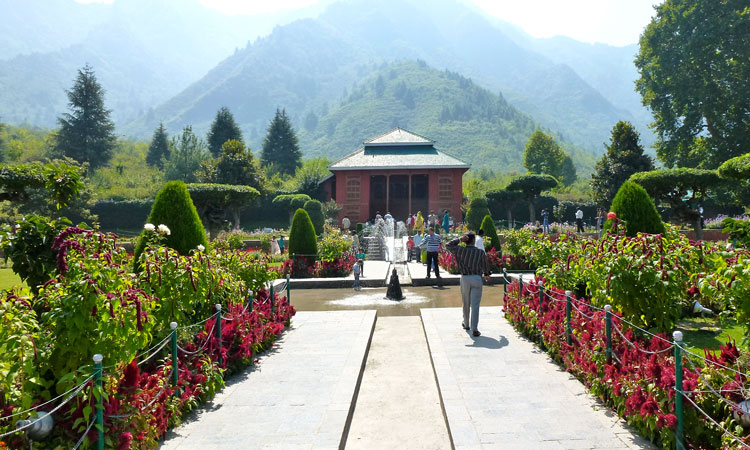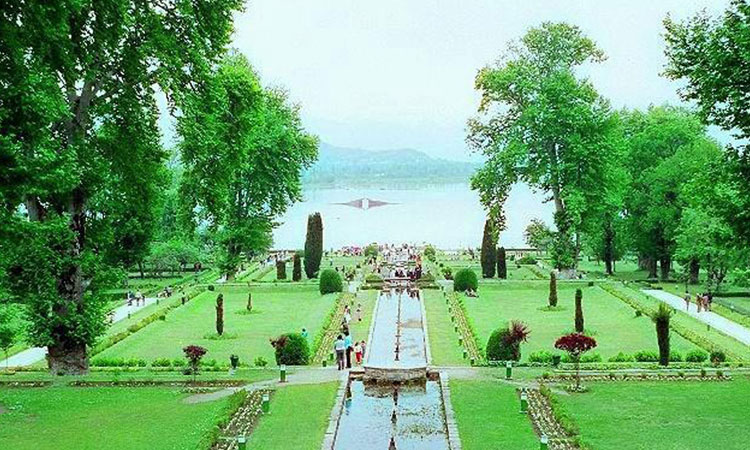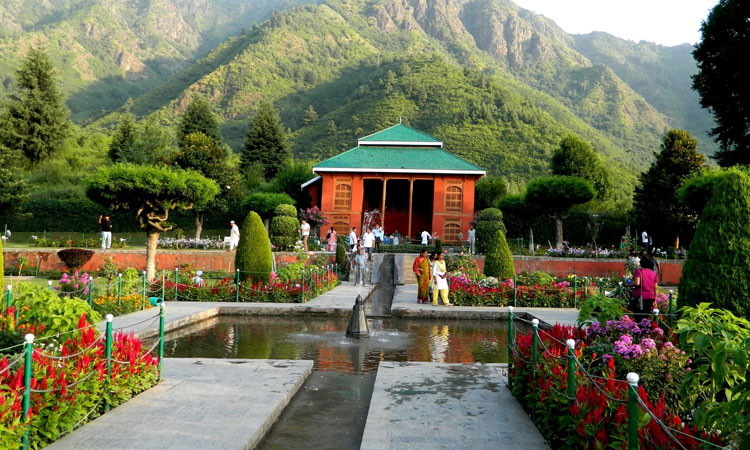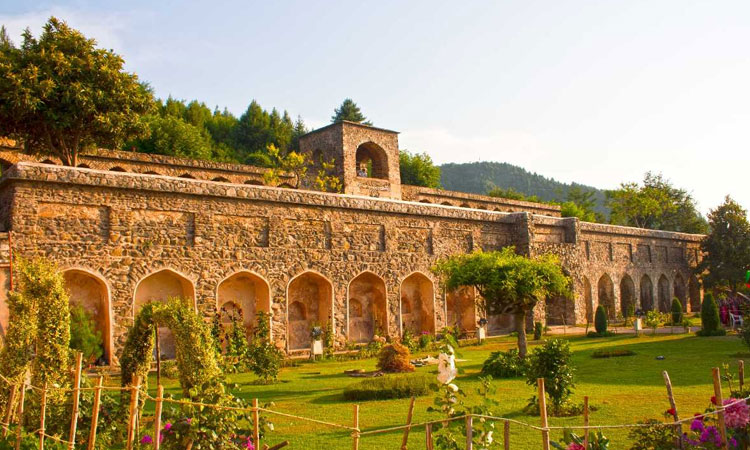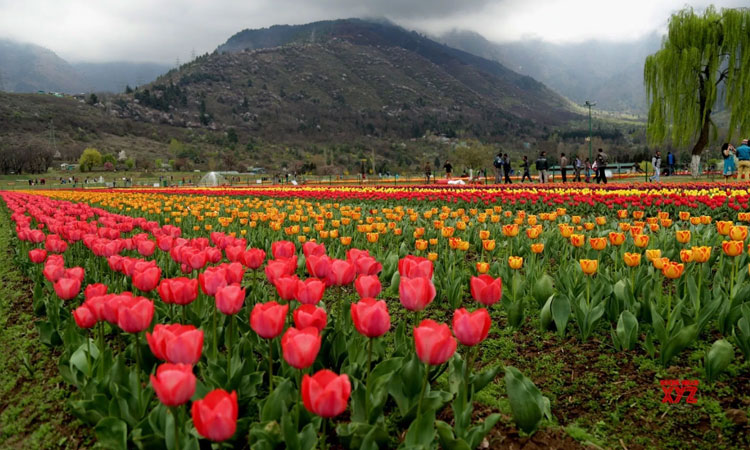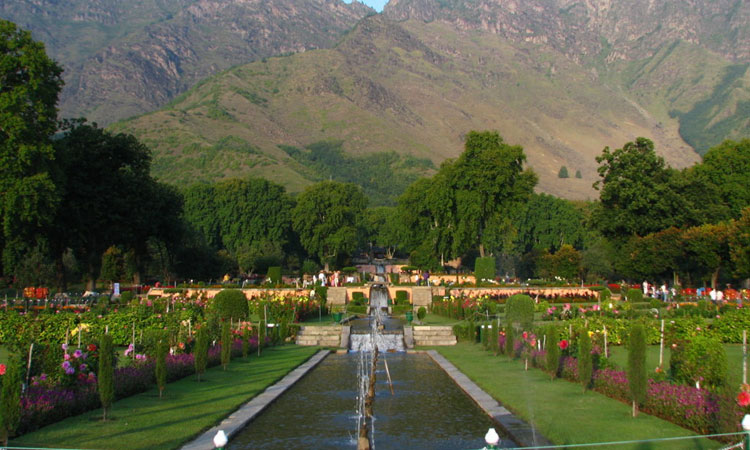Kashmir Gardens Surf around the lush green gardens & colourful flowers ....
Shalimar Bagh
One of the most famous garden in Kashmir valley, Shalimar garden is situated on the shores of serene Dal Lake. The word 'Shalimar' itself defines the reason of its construction which indicates 'abode of love'. Therefore, the 'house of Love' was built by Mughal Emperor Jehangir for his beloved wife Nur Jahan, around 400 years back.
The lush green and well-maintained Garden of Srinagar designed with terrace lawns, fountain pools and flower beds combined with mighty chinar trees and pavilions. The interior of Shalimar Bagh contain four terraces in which the top most terraces was originally reserved for the royal ladies and is considered to be the most beautiful section.
During autumn and spring season the picturesque surrounding of the 'Bagh' looks amazing as the Chinar trees change their color from green to orange. Shalimar Bagh is also popular with different names- Shalamar Garden, Shalamar Bagh, Farah Baksh and Faiz Baksh etc.
Nishat Bagh
Also known as "the garden of bliss", Nishat Garden in Srinagar is set on the banks of the beautiful Dal Lake. The garden is set at the backdrop of the snow capped Pir Panjal mountain range and it offers a great sunset view of the Dal Lake. A beautiful water channel flows right in the middle of the garden. Nishat Bagh was designed by Asaf Khan, the brother of Nur Jahan back in 1633 AD. The garden has 12 terraces, one for every zodiac sign and they keep on rising up the mountain side. All the terraces are filled with different colored roses, lilies, geraniums and asters.
Nishat Garden is the very famous garden of Srinagar as well as most visited tourist spot. Peoples come from all over world to visit the beauty of the place. Tourists not only get to enjoy the scenic view of the gardens but also can enjoy Shikara rides at the Nehru Park. There are many shopping stalls outside the garden from where tourists can shop different items.
Chashma Shahi
Chashme Shahi garden is a terraced lawns, fascinating fountains and floral beds on the banks of Dal Lake. Beautifully terraced garden and a colorful flowers make Chashme Shahi beautiful than any other parks and gardens of Kashmir. Originally Shah Jahan's creation in the year 1632 it has undergone a number of renovations to retain its remarkable beauty. Shah Jahan named the garden after a mountain spring that waters it and so it has the name Chashme Shahi.
The gardens include three terraces, an aqueduct, waterfalls and fountains. Chashme Shahi is the Ist Mughal Garden you will come across after Nehru Park. Smallest of the Srinagar Mughal gardens, the Chasma Shahi, or 'Royal Spring'' are well set up the hillside, above the Nehru Memorial Park.
The fresh water spring in these pleasant, calm gardens is renowned to have medicinal values. There is also a small shrine, the Chasma Sahibi, close to the gardens, which also has a fresh water spring.
Pari Mahal
One of its major attractions is Pari Mahal. Pari Mahal is an attraction well known for its natural beauty and tranquility. Set right at the top of the Zabarwan mountain range, Pari Mahal is a beautiful historic monument. The architecture of the structure features Islamic architecture and styles of art which prevailed during the reign of the Mughal Emperor, Shah Jahan. The monument is located amid seven terraced beautiful gardens which add to the beauty of the structure. The gardens have a variety of flowers and trees which give the place a serene environment.
The main attraction of the place is the view which it offers. Pari Mahal offers a great view of the Chinar trees in the surrounding area and the Dal Lake. The attraction can be visited all around the year. However, the best time to visit the place is from April to October when the weather remains pleasant.
Tulip Garden
One of the best garden to visit in Month of April in Srinagar, Tulip Garden is located in Siraj Bagh area, covering the banks of Dal lake with a colorful carpet of flowers. With an area of around 12 hectares, it is also known as the largest tulip garden in the whole of Asia. Flaunting hundreds of varieties of Tulips, the enchanting garden sprawls over the foothills of Zabarwan mountain ranges, overlooking the picturesque Dal Lake.
Owing to such a huge spectrum of tulips, the garden acts as a tourist magnet, especially during the blooming months of the flowers. In order to watch the largest collection of freshly germinated colorful tulips, one must schedule his visit between the months of March and May. To the delight of florists, the concerned department of the state also organizes a Tulip festival during March-end every year. Thronging a large number of tourists, the Tulip festival in Srinagar is considered to be amongst the biggest of the events.
Harwan Garden
Situated about 18 km from Srinagar, Harwan is a huge garden lined with flowerbeds and massive Chinar Trees. A canal passes through its centre, which is dotted with countless flowers. The sweet fragrance in the air and big green-carpeted lawns make it an ideal spot for picnics and excursions. The garden serves as a gateway to the famous wildlife sanctuary of Dachi Gam and Mahadev Mountain.
Behind the garden, there is a small but beautiful Harwan lake that feeds the garden and provides an astounding view of the majestic mountains. The place offers you a natural feel, away from the polluted and noisy urban life.
Nehru Botanical Garden
Nehru Garden in Srinagar A well-designed modern garden at the foothills of the Zabarwan mountain range in Srinagar, Nehru Botanical Garden is where every florist or nature lover would surely love to unwind. As Nehru Botanical Garden in Srinagar is designed as per modern techniques and terms, the four sections can be explained as Recreational Garden, Botanical Garden, Plant Introduction Center and Research Section.
Amongst the best places to rejuvenate in nature, the property has several inner gardens to boast upon, the themes of which are highly intriguing. Strolling along the inner gardens gives visitors a chance to watch over three hundred species of flowers, all at one place.
During the spring time, the Nehru Botanical Garden witnesses a chaos of colors and fragrances, thus, it is advised that one must make his plans keeping this thing in mind. Besides the lovely flowers, boating is also amongst the star attractions in Nehru Garden. For this, the property has a beautiful lake which allows joy rides by boats. All in whole, the beauty and tranquility of the renowned Nehru Botanical Garden make it a top tourist spot in Srinagar.
Achabal Garden
Achabal is situated at a distance of 58 km from the district of Srinagar. Reached via Anantnag, Achabal served as the pleasure retreat of the Mughal Empress Nur Jehan. Situated at a height of 1,677 m, Achabal is a visual treat for the eyes. Achabal is adorned with one of the best Mughal Gardens in India.
Resplendent in a history that dates back to the times of the Mughal rulers in India, much of the Kashmir Valley is scattered with gardens and palaces which are relics of the rich architectural heritage which we have inherited from the glorious rule of the Mughals in India. One of these is a garden built as a pleasure retreat of Empress Noor Jahan, the wife of Emperor Jahangir and one of the most charismatic empresses of the Mughal Era. A tour to Achabal is the perfect way to witness the charming Mughal architecture. Located at a height of 1,677 meters above sea level and around 58 kms away from Srinagar, a tour to Achabal is the perfect weekend getaway from Srinagar.
Verinag Garden
Waterfall at the end of Verinag Mughal Garden Mughal Garden of Verinag located about 61 km south of Srinagar at the foothill of Banihal Mountain ranges. Covering a total area of 5.30 hectares, the garden fascinates the tourists with its beautiful manicured lawns, flower beds, majestic chinar trees and gushing spring at the backdrop of lush and dense forest.
Verinag garden was originated from a gushing mountain spring of Verinag, which is the source of the River Jhelum. Mughal Emperor Jahangir was impressed by the beauty of the spring and its surrounding areas. Soon then, he built an octagonal water tank of sculptured stones in 1620 AD. Seven years later, his son Shah Jahan added some attractive features to the garden and constructed fountains and cascades in row lines in front of the spring. He also built hot and cold baths in the garden of which only ruins are now left and preserved.

